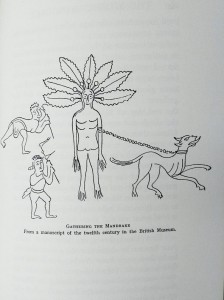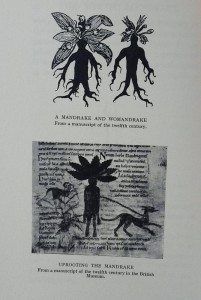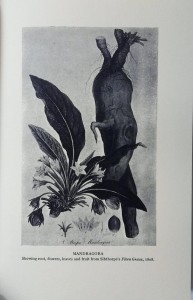This post is part of an ongoing series featuring items from the newly acquired Santo Domingo collection.
 The mandrake root is often referenced in mythical texts and stories, with many powerful magical powers ascribed to it. The root can resemble human limbs and rumor is that when it is pulled from the ground it lets out a blood curdling scream that can kill anyone who hears it. In the introduction, Leslie Shepard tells the myth of how to remove the root.
The mandrake root is often referenced in mythical texts and stories, with many powerful magical powers ascribed to it. The root can resemble human limbs and rumor is that when it is pulled from the ground it lets out a blood curdling scream that can kill anyone who hears it. In the introduction, Leslie Shepard tells the myth of how to remove the root. 
“You had to stop your ears with wax, expose enough of the plant to tie it to a dog, then incite the animal to pull the mandrake, the dog dying in the process. After that the plant was safe to handle and had various magical properties.” The root was clearly thought to be a very powerful magical object if people were willing to risk death to obtain it! Although the plant does have mildly medical qualities, in ancient Rome it was used as an anesthetic and was later used to treat rheumatism, it is in fact a very dangerous plant as the berries contain a very potent poison.
This book, The Mystic Mandrake, follows the history of the plant for 3,000 years, from ancient civilizations to current times both looking at the medical and scientific aspects of the plants as well as addressing the magic and superstition that surrounds the root. Long considered an aphrodisiac, many herbalists discuss the different male and female incarnations of the plant. Written by C.J.S. Thompson, the curator of the museum at the Royal College of Surgeons, this book is well researched and thorough. Thompson looks at different literary references, including Shakespeares’ Antony and Cleopatra, as well as historical documents and objects to weave his story about the magical plant.  Thompson wrote extensively on plants and poisons, as well as the links between the medical world and the magical. Several other of Thompson’s books can be found at Harvard including The Quacks of Old London, Magic and healing, and Poisons and poisoners, with historical accounts of some famous mysteries in ancient and modern times. The Mystic Mandrake is part of the Santo Doming Collection and can be viewed at Widener Library.
Thompson wrote extensively on plants and poisons, as well as the links between the medical world and the magical. Several other of Thompson’s books can be found at Harvard including The Quacks of Old London, Magic and healing, and Poisons and poisoners, with historical accounts of some famous mysteries in ancient and modern times. The Mystic Mandrake is part of the Santo Doming Collection and can be viewed at Widener Library.
Thanks to Emma Clement, Santo Domingo Library Assistant, for contributing this post.
